In the book A Particular Place: Urban Restructuring and Religious Ecology in a Southern Exurb, Dr. Nancy Eiesland outlines how two particular congregations grew in an area outside Atlanta. Notice how she describes the changes in the local ecology of the community that led to the rise of the congregation:
“Founded in 1942, Hebron Baptist is a historic congregation that has successfully adapted to a dramatically altered environment. Fifteen years ago, it was among the smalls of the dozen or so small Baptist churches in and around Dacula. In 1995, drawing congregants from seven surrounding metropolitan counties, Hebron was a congregation of nearly 3,400 regular worshipers, surpassing the total number of residences within Dacula city limits. The congregation’s story is a classic tale of church growth on a metropolitan frontier. In the 1980s, then Gwinnett was the fastest growing county in the United States, Hebron kept pace with the steady population inflow, becoming the primary beneficiary of exurban growth in the area. Its optimal location on the periphery of Dacula near the community’s newly constructed elementary school and abutting several high-density subdivisions gave it high visibility among exurban newcomers. Likewise, denominational support (in the form of financial subsidies from the national and state Southern Baptist Conventions and the expertise of the denomination’s church growth specialists) allowing this small congregation to take full advantage of the demographic transformations occurring around them.
The church’s pastor, Bryant Quinn, whose nearly twenty-year tenure provided a high degree of leadership stability and consistent outward vision, was very deliberate in addressing the needs of newcomers by updating the congregation’s worship services. In 1977, when the south Georgia native came to the church as a twenty-four-year-old Mercer University graduate, he began going out on rounds with the Dacula Fire Department. As he sat with families who experienced tremendous personal tragedy, he realized that many had no one locally to support them during difficult times. Cognizant of the history of residential mobility and concomitant absence of local support systems among many newcomers, Quinn led the Hebron congregation in aggressive evangelism in the area’s burgeoning subdivisions. The church’s slightly more than one hungered congregants began canvasing each neighborhood once or twice in a month inviting families to attend special programs at the church. The evangelistic blitz spanned a new verb in the area, as locals inquired if new subdivisions had been ‘hebroned’ lately.”
This quote talks not just about the ecology of the community, but in the leadership and authority of the pastor, Bryant Quinn. He recognized a need in the community, and made that need a mission of the community. A number of factors allowed Hebron Baptist to grow right at that particular moment — a large influx of individuals in the community, support from the broader denomination, a strong and knowledgable pastor, and dedicated laity focused on growing the congregation. Some of this was being in the right place at the right time, but other factors were developed and created by the community. What sort of situations surround your community that your church has yet to capitalize on? Is there a set of new immigrants in need of support or care? A student population from a local college you can support? Pastor Quinn saw places where the community was in need, and incorporated that into the vision of the church. What are the needs in your community?

